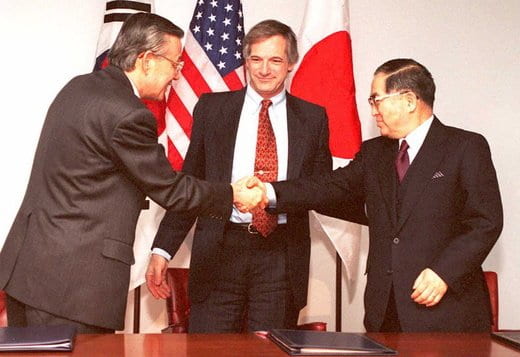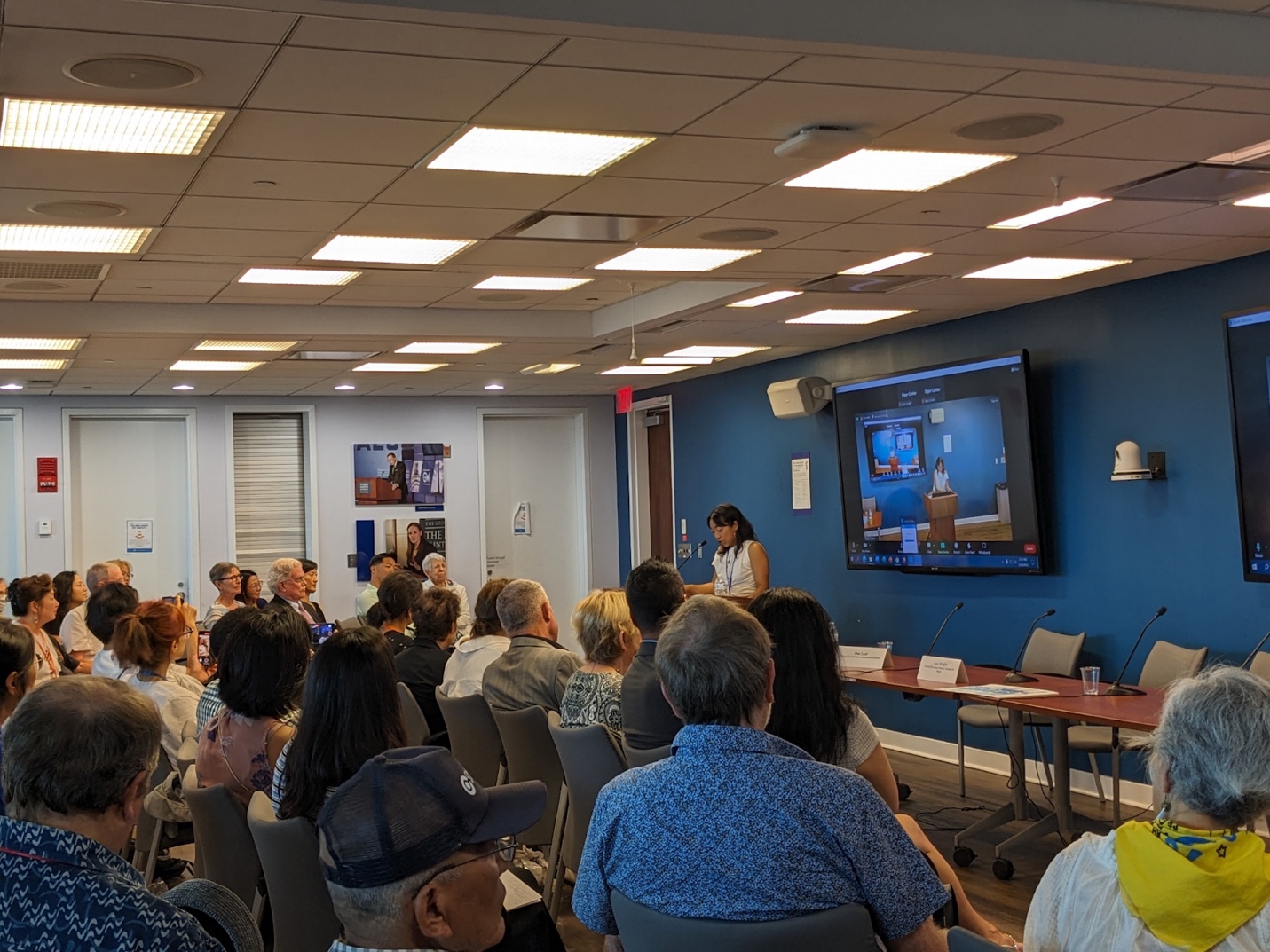
“Sanctions kill; we know it and we should not accept that,” said Kee Park, a medical doctor from Harvard Medical School’s Program in Global Surgery and Social Change, during a conference at George Washington University held as part of a national mobilization to end the Korean War.
Park cited the high death toll of sanctions that target North Korea’s civilian economy. “We have become barbarians because we accept the death of children and women in the name of regional and national security.”

That security, however, is increasingly tenuous as in June, the U.S. sent a nuclear-powered ballistic missile submarine to South Korea, and docked a second one on July 24, triggering a crisis that could lead to an all-out war.
When it comes to nuclear escalation, “all it takes is a misunderstanding,” said Dan Leaf, who was Deputy Commander of the U.S. Pacific Command. “That in a lot of ways for me is way more terrifying than a rational decision,” said Ji-Yeon Yuh, a professor of History and Asian-American Studies at Northwestern University. Yuh also moderated a panel addressing the risks of nuclear warfare.
After 70 years under the Korean Armistice Agreement, the U.S. and the Democratic People’s Republic of Korea (D.P.R.K.-North Korea) are still at war.
But organizers of last month’s historic mobilization are working to change that. “When we started to conceive of this conference, we felt it was important to bring together a combination of experts who are changing the way we all think about the Korean War and its ongoing impact,” said Christine Ahn, the executive director of Women Cross DMZ. “We wanted to center the stories of individuals whose families have been torn apart by war and the obstacles they continue to face due to the absence of peace, as well as humanitarian experts who understand intimately how U.S. policies continue to shape the day-to-day existence of North Korean people.”

Panelists met to discuss the risk of greater conflict and the peace movement’s demand to end the longest war in American history.
By October 1951, U.S. News and World Report had already called the Korean War “the forgotten war.” But 70 years after the armistice, North Korea is testing missiles, the South Korean government has resumed THAAD expansion despite civilian protests, and the U.S. has reaffirmed its security alliance with the R.O.K.

Meanwhile, families remain divided by the Demilitarized Zone and sanctions endanger the lives of North Koreans.
On September 2, 1945, Japan surrendered in World War II, marking the end of Japanese rule over Korea. Anticipating the formal surrender, the U.S. and the Soviet Union agreed to divide the peninsula at the 38th parallel.

The circumstances in which war broke out on June 25, 1950, between North and South Korea are not completely understood. There are allegations that South Korean forces initiated the war by crossing the 38th parallel and capturing Haeju and, in 1949, there were several instances of border clashes, some instigated by Kim Il Sung and many by Syngman Rhee.
Both wanted to reunify the peninsula under their authority. The North Korean People’s Army crossed the parallel and captured Seoul three days later.
The U.S. and South Korean armed forces were responsible for the majority of civilian casualties during the war. According to one estimate, up to 1.5 million North Korean civilians were killed in aerial attacks that involved the use of napalm. In the No Gun Ri Massacre, U.S. soldiers were instructed to kill upwards of 300 South Korean refugees who were ordered to leave their villages and travel south.
Experts agree that tens of thousands of South Koreans were killed by South Korean police and military in the Bodo League massacre, including up to 7,000 in Daejeon as U.S. officers watched and photographed them.

Australian journalist Wilfred Burchett first broke the story about how the U.S. military used germ warfare in Korea, among the worst atrocities of the war. Although no nuclear weapons were used, President Truman threatened to use them; other proponents included General Douglas MacArthur and then-Senator Lyndon B. Johnson.
Peace negotiations between the UN Command, North Korea, and China lasted two years until the parties signed the Korean Armistice Agreement on July 27, 1953, in Panmunjom, Korea.

Nuclear Blackmail
The conference’s keynote speaker was historian Bruce Cumings, author of Korea’s Place in the Sun (1997) and a two-volume history on the origins of the Korean War among other works. Professor Cumings’s presentation provided a detailed historical background of events leading up to the signing of the armistice and U.S. nuclear policy on the Korean peninsula, which he later described as “a centerpiece of American nuclear diplomacy and nuclear policy going back to 1951.”

Pleas against nuclear threats did not prevent escalations after the armistice that would violate the agreement. President Dwight Eisenhower sent the first atomic bombs to South Korea in 1958. Professor Cumings said the U.S. regarded North Korea as a safe target for nuclear threats because of its belief that neither the USSR nor China would retaliate with nuclear strikes.

After North Korea seized a U.S. spy ship in 1968, then-President Lyndon B. Johnson again considered a nuclear strike. President Nixon would also threaten one a year later. The U.S. then increased joint military exercises with South Korea such as Team Spirit and Foal Eagle.
Professor Cumings emphasized the role of “nuclear blackmail” in exacerbating unresolved tensions with North Korea. “All presidents, Republicans and Democrats, consistently try to intimidate North Korea by flying nuclear-capable bombers into the Korean theater.”
These provocations, said Cumings, inform North Korea’s desire for a security guarantee.

Although the U.S. withdrew tactical nuclear weapons from Korea in 1991, it can still threaten North Korea because of newer “precision-guided conventional weapons.”
According to researcher Donghyun Woo, North Korea’s initial interest in nuclear power was not for weaponry but to keep up with its electricity needs.
In 1991, North Korea separated an amount of plutonium from a reactor at the Yongbyon Nuclear Scientific Research Center too small to make a crude bomb. Having signed the Nuclear Non-Proliferation Treaty in 1985, North Korea “saw their nuclear program, their plutonium, as a bargaining chip to get normal relations with the U.S.,” said Cumings.

In 1994, President Bill Clinton considered a preemptive strike on the facility after increased sanctions and nuclear inspection disagreements. The U.S. and North Korea instead negotiated the Agreed Framework. “Direct talks at the highest level get things done,” Cumings said. “That’s the history of the 1990s.”

The U.S. agreed to assist North Korea with energy needs if it froze its graphite-moderated nuclear reactors. In 2000, both Korean governments signed the June 15 North-South Joint Declaration, leading to reunions of divided families and increased economic cooperation.
The second Bush administration rejected South Korea’s Sunshine policy, listed North Korea as part of an “axis of evil,” and expanded military bases on the peninsula.
In 2006, North Korea tested its first nuclear weapon. After more tests and the Obama administration’s “strategic patience” policy, President Trump said that, if North Korea continued its actions, it would “be met with fire, fury, and frankly power the likes of which this world has never seen before.”
A diplomatic breakthrough came in 2018 when President Moon Jae-in and President Kim Jong-un pledged to convert the armistice to a full peace treaty. Trump later met Kim at the historic Singapore Summit but talks broke down in Hanoi over disagreements on sanctions relief and North Korea’s weapons program.

Four years on, President Joe Biden and his counterpart Yoon Suk Yeol have restarted military drills and signed the Washington Declaration, which allowed this summer’s docking of U.S. nuclear submarines on the peninsula.
“North Korea is a nuclear power, it will always be a nuclear power, and that has to be put to the side so that other things can be accomplished rather than trying to get them to give up something that none of us would give up,” Cumings told the conference. “It doesn’t matter who would be governing in Pyongyang under this kind of threat, the first thing they would want as soon as possible is a nuclear weapon.”
Cumings ended by expressing the urgent need for investigative history and reporting on North Korea and a greater effort toward understanding. “Nuclear war could break out and we hardly ever get anything but propaganda,” said Cumings, adding that “We remain in denial about a conflict almost 80 years old and within an inch of breaking out again.”
The Human Cost
The first panel was themed around the human cost of the ongoing war. “We can probably spend the entire day just on this panel,” said moderator Jennifer Deibert, the DPRK Program Director at the American Friends Service Committee. “The three panelists we have here today carry three important stories of the impact of divided families, missing families, and working with families seeking health and well-being.”

Rick Downes, president and executive director of the Coalition of Families of Korean & Cold War POW/MIAs, spoke about the war’s impact on his family. He shared a story, “one of thousands of stories,” about his young father who went missing within ten months of being deployed in Korea and is still listed as missing-in-action.
Downes’s work with the Coalition has led to successful recovery of the remains of a number of POW/MIAs, but he said in the panel discussion that while the “DPRK has been more than cooperative in a number of times…it’s our own government that has often been the problem.”
“The need to know what happened is incredibly poignant and valid,” he said. “Our quest now is to get the governments to talk.”
Divided family member Joy Gebhard told the panel she has not been able to see loved ones in North Korea for seven years.
Gebhard was separated from her family shortly after graduating from middle school, a few months after war broke out. Her mother believed that she would be safer in South Korea and allowed her to go. “Her last words to me were, ‘Seoul is cold. Keep warm. Stay alive, and do right.’” Gebhard entered military nursing school and eventually emigrated to the U.S. She wrote letters to her family that were never returned.
In 1988, after many years of searching and waiting, Gebhard received a letter from the D.P.R.K. It was from the Office of Assistance for Korean Fellow Men Abroad saying that they had located her family and that she may visit them at any time. Between 1988 and 2016, Gebhard visited North Korea many times to see her family, but she has not been back since 2016 due to the travel ban.
Gebhard wishes to be able to see her family again soon. “I am close to 90. My time is limited.”
“I cannot visit my own flesh and blood. I cannot visit the graves of my parents. I cannot even send a letter due to the sanctions. As one of the oldest separated Korean-American families, I ask my government to remove the sanctions, allowing separated families to reunite and end this ongoing war once and for all.”

Dr. Kee Park framed the un-ended war as an issue of public health. He explained that North Korea’s military spending is partly motivated by the fact that “North Korea still considers themselves at war.”
Despite increased military spending, Dr. Park argued, North Korea’s top priorities still include the maintenance of health and free health care as well as free education. He cited that North Korea spends “six to seven percent of GDP on health” and has “increased the import of insulin by ten-fold” over the last couple of years, enough to treat 70% of its diabetic patients.
“When you hear some people say North Korea doesn’t care about their people or that they have abandoned their people to prioritize their military, it simply is not true.”
During the first panel, Park also discussed the impact of sanctions on public health in North Korea, calling sanctions “warfare without bullets.” In a Korea Peace Now! Report titled The Human Costs and Gendered Impact of Sanctions on North Korea, he and his research team found that almost 4,000 North Koreans had died in 2018 as a result of sanctions.
He emphasized that peace is a public health issue. “For a health practitioner like myself, peace is a prerequisite for health.”
One Bad Decision Away
“It’s going to be a very difficult journey to get denuclearization now,” Siegfried Hecker, the former director of the Los Alamos National Laboratory, said during the second panel on the threat of nuclear war.
Hecker said that because nuclear-armed countries have tended to cooperate, we have avoided worse scenarios when it comes to atomic warfare. “For three decades, we’ve had an opportunity to constrain North Korea’s nuclear program and we’ve failed,” Hecker told the conference. “North Korea was seriously interested in normalization with the United States. That has now dramatically changed.”
Ji-Yeon Yuh opened the discussion by asking about the signs pointing to North Korea’s desire to normalize ties with the U.S. “Around 1990, we had what some people call a pattern change in North Korea’s leadership,” said Hecker. That’s when North Korea decided to seek out paths to normalization with the U.S. “The most immediate example of what happened is what led to the Agreed Framework,” Hecker told attendees, adding that the Bush administration shattered the deal.
North Korea still reached out to Washington multiple times during the Bush and Obama presidencies. The last three North Korean heads of state “had a serious interest in trying to reach normalization through dialogue with the United States,” said Hecker. But because they were not sure it would work out, Hecker said they concurrently developed nuclear weapons.
“We’re one bad decision away from nuclear war with North Korea,” said retired General Dan Leaf, who shared how a misunderstanding in the 1980s led to the U.S. forces shooting down two Libyan MiG-23 planes. The lead pilot was not trying to attack U.S. warplanes but, instead, was trying to pass his annual check ride. “That happens in the fog of war at that finite level.”
A similar escalation could occur if North Korea launches a missile test over Japan at a high trajectory, Leaf argued, especially given the likelihood such tests can fly lower than planned and appear to be threatening an overflight. The general said a U.S. misreading and response to such a test could lead to nuclear conflict. In Leaf’s opinion, “a legitimate, aggressive, persistent pursuit of a peace treaty” is the one unequivocal pathway to break this chain of nuclear threats.
“One of the many reasons we don’t have a peace treaty is it has never been anybody’s job in the United States government,” Leaf told the conference, adding that we need an office responsible for handling logistics around resolving the Korean War. “If we’re not doing that serious work of peace, we’re not serious about peace.”
“We keep getting stonewalled by our government,” said peace activist and retired Army Col. Ann Wright. When Yuh asked her about the state of the peace movement, Wright said “we have to keep going.” Thirty-three members of the U.S. House of Representatives have co-sponsored H.R 1369, the Peace on the Korean Peninsula Act. Wright is also a proponent of more people-to-people relations and lifting the travel ban. “It’s a life-changing experience as anyone who’s been to North Korea knows.”
Wright was one of the women who crossed the Demilitarized Zone in 2015 on a peace walk organized by Christine Ahn. “It’s up to us to push for these opportunities to get to know people, to be able to tell our community that there’s no way in the world that we would ever want a nuclear attack or non-nuclear attack on North Korea, that we stand for having peaceful relations with countries.”
“You can go to your symphony, or whoever’s in the community that you think might be able to pull something like this off and all of the sudden, you can make an overture to North Korea,” Wright told the conference.
The colonel implored attendees to go beyond Washington’s lack of engagement. “We’ve got to embarrass our own government to do what’s right.” She also encouraged citizens to press politicians about the weapon industry’s influence in American security policies.

Next Steps
Cathi Choi, director of policy and organizing for Women Cross DMZ, gave the conference’s closing remarks. Like Gebhard, Choi is a member of a family divided by the Korean War. “It is only through our ancestors’ perseverance that I’m standing here,” the former civil rights attorney told the conference.
“Unless we act, our communities and environment will suffer devastating consequences as our presence expands across the Pacific. The U.S. recently announced a missile defense system to be built on Guahan—Guam—which comprises up to 20 sites across the island and is billed as a response to perceived threats from ‘potential adversaries’ like China and North Korea,” said Choi.

“Next year, the U.S. will hold the Rim of the Pacific (RIMPAC), which is the largest annual maritime warfare exercise in our oceans,” Choi said, adding that organizers of the conference honor the struggles of those in Hawaii, Guahan, the Philippines, and Okinawa. “When we fight for Korea, we fight for all occupied lands; we honor their struggle as they honor ours.”
Choi finished by saying, “ours is a movement of life and of love, and together we will see an end to this war and peace in our lifetimes.”
“There are many opportunities to continue to build on the momentum we generated this week,” Christine Ahn told CovertAction Magazine reporters on the Sunday after the conference. “I’m hopeful that the 30-under-30 youth will continue to build community and launch projects and initiatives that keep the momentum growing.”
“I feel invigorated,” said Hayden Smith after the conference. Smith was one of the 30-under-30 participants. “Finding ways where we can build links of solidarity with people who are within the Korean-American community and outside of it” is the next step, in his point of view.
Another 30-under-30 member, Sheen Kim, said “Ultimately, what this emphasizes is that it’s organizing” that will end the war. “There’s nothing kind of like the in-person movement to show you that there actually is an entire world of people who are standing in solidarity with you.”

CovertAction Magazine is made possible by subscriptions, orders and donations from readers like you.
Blow the Whistle on U.S. Imperialism
Click the whistle and donate
When you donate to CovertAction Magazine, you are supporting investigative journalism. Your contributions go directly to supporting the development, production, editing, and dissemination of the Magazine.
CovertAction Magazine does not receive corporate or government sponsorship. Yet, we hold a steadfast commitment to providing compensation for writers, editorial and technical support. Your support helps facilitate this compensation as well as increase the caliber of this work.
Please make a donation by clicking on the donate logo above and enter the amount and your credit or debit card information.
CovertAction Institute, Inc. (CAI) is a 501(c)(3) non-profit organization and your gift is tax-deductible for federal income purposes. CAI’s tax-exempt ID number is 87-2461683.
We sincerely thank you for your support.
Disclaimer: The contents of this article are the sole responsibility of the author(s). CovertAction Institute, Inc. (CAI), including its Board of Directors (BD), Editorial Board (EB), Advisory Board (AB), staff, volunteers and its projects (including CovertAction Magazine) are not responsible for any inaccurate or incorrect statement in this article. This article also does not necessarily represent the views the BD, the EB, the AB, staff, volunteers, or any members of its projects.
Differing viewpoints: CAM publishes articles with differing viewpoints in an effort to nurture vibrant debate and thoughtful critical analysis. Feel free to comment on the articles in the comment section and/or send your letters to the Editors, which we will publish in the Letters column.
Copyrighted Material: This web site may contain copyrighted material the use of which has not always been specifically authorized by the copyright owner. As a not-for-profit charitable organization incorporated in the State of New York, we are making such material available in an effort to advance the understanding of humanity’s problems and hopefully to help find solutions for those problems. We believe this constitutes a ‘fair use’ of any such copyrighted material as provided for in section 107 of the US Copyright Law. You can read more about ‘fair use’ and US Copyright Law at the Legal Information Institute of Cornell Law School.
Republishing: CovertAction Magazine (CAM) grants permission to cross-post CAM articles on not-for-profit community internet sites as long as the source is acknowledged together with a hyperlink to the original CovertAction Magazine article. Also, kindly let us know at info@CovertActionMagazine.com. For publication of CAM articles in print or other forms including commercial internet sites, contact: info@CovertActionMagazine.com.
By using this site, you agree to these terms above.
About the Author

Cale Holmes is a journalist focusing on war and peace, social justice movements, and the climate crisis.
A graduate of Columbia Journalism School, he’s based in Washington, D.C.
Cale can be reached at: cale.holmes1131@gmail.com.

Jamie Kim, MPAff, is a 30-Under-30 Korea Peace activist.
Jamie was born in Korea, raised in Little Rock, Arkansas and is currently based in Austin, Texas.
Jamie can be reached at: jamie.yc.kim@gmail.com.





